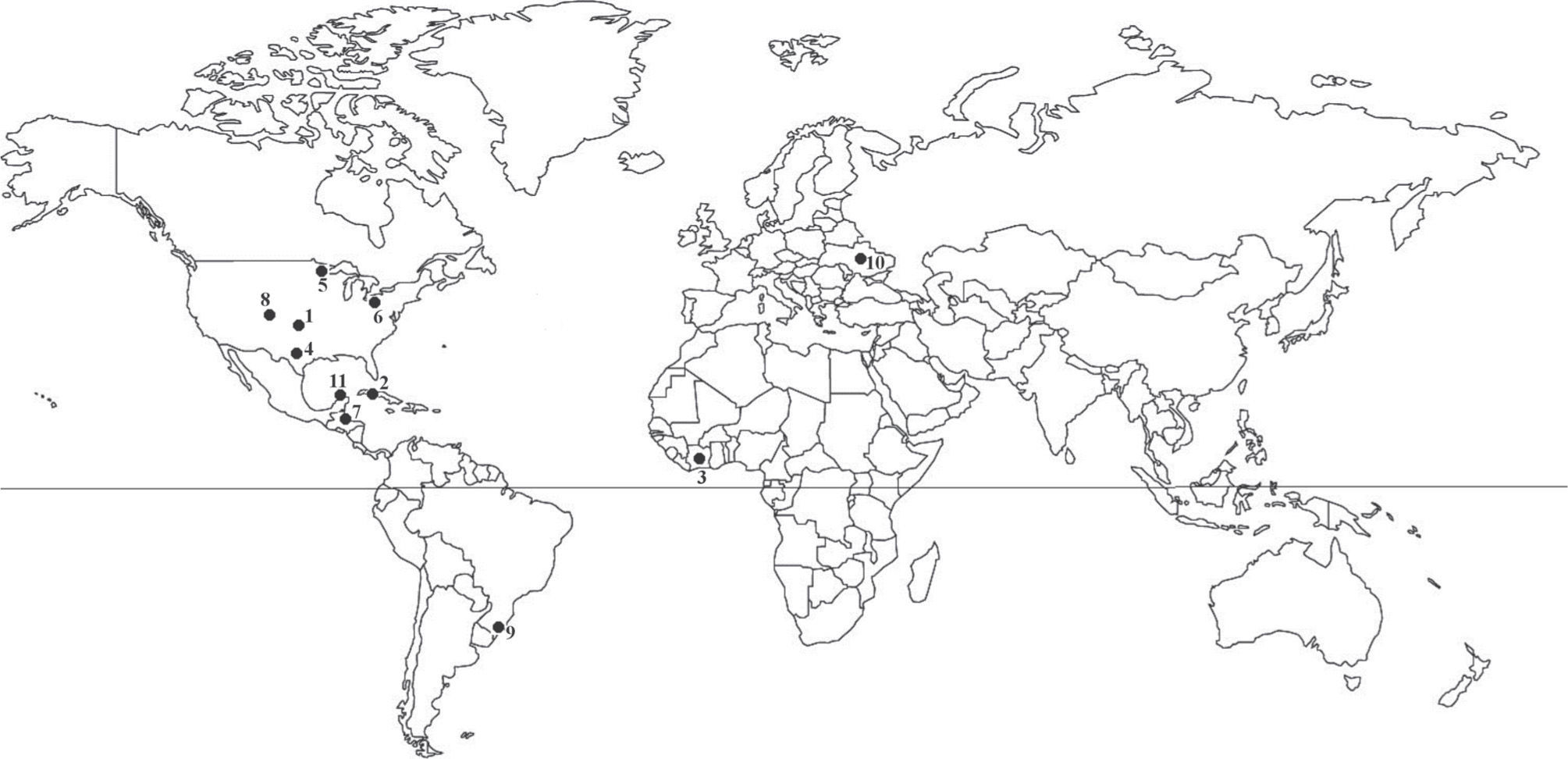Morphological description of Thompsodinium intermedium found in a karstic sinkhole Dzityá, in Yucatán is provided. This is the only locality in Mexico where the species has been recorded. Taxonomic circumscription of the species has changed considerably since its original description. An emended diagnosis for the species is provided, as well as for the genus. Worldwide distribution of Thompsodinium intermedium is provided.
Se proporciona la descripción morfológica de Thompsodinium intermedium encontrado en el cenote Dzityá en Yucatán, único registro en México. La circunscripción de la especie ha cambiado considerablemente desde su descripción original, por lo que se propone una diagnosis enmendada para la especie y para el género. Se muestra la distribución mundial de Thompsodinium intermedium.
Cenote Dzityá (or Chen-Ha) is a small karstic sinkhole (10.89 x 7.40 m, 4.60 m mean depth) located close to Mérida City, Yucatán Mexico (21.06° N, 89.69° W). In 2 samples of phytoplankton collected in April and May 1999 from this sinkhole, the occurrence of a dinoflagellate was observed. This microalga was studied by light (Leica dmil) and electron microscopes (SEM-JEOL-5600). The morphology indicates that the species belongs to the genus Thompsodinium Bourrelly. Description of the species follows:
Thompsodinium intermedium(Thompson) Bourrely 1970: the cells are 20-32 μm in width and 22-33 μm in length with a ratio width/height of 0.7-0.95, so the cells are ovate or spherical. The cells are dorsoventrally slightly compressed. Many small chloroplasts and a small eyespot are present. Tabulation is Po, x, 4’, 3a, 6’’, 6c, 4s, 5’’’, 2’’’’ (Figs. 1, 2). The second intercalary plate and the third apical plate can be in “remotum” or “contactum” position. The sulcal posterior plate is large extending to the antapex looking like a plate of hypotheca. The third and fourth postcigular plates are large and the antapical plates are dissimilar in size and shape.
Diagnostic characters of the species have changed in the interpretation of the type of hypothecal and sulcal plates (Table 1). Nowadays, the intercalary plate at hypotheca described by Thompson (1950) is known to be a large posterior sulcal plate (Sp) (Carty 1989). Since the original description is not correct anymore, an emended diagnosis of the species (and therefore the monotypic genus) is necessary to attain an adequate taxonomic circumscription of the species:
| Species | Measures (μm) | Plate formula* | Additional character | Location | Reference |
|---|---|---|---|---|---|
| Peridinium intermedium | 32-39 long, 33-40 wide | 4’, 3a, 6’’, 5’’’, 1p, 2’’’’, remotum or contactum | No | Abandoned clay pit, Chanute, Kansas, USA | Thompson (1950) |
| Peridinium intermedium | 30-46 long, 28-40 diameter | 4’, 3a, 6’’, 5’’’, 2’’’’ | Wing-like rim | Laguna del Tesoro, Cuba | Popovský (1970) |
| Thompsodinium intermedium | No information | 4’, 3a, 6’’, 5’’’, 1p, 2’’’’ | No | No information | Bourrelly (1970) |
| Peridinium pseudointermedium | 36-40 long, 30-33 wide | Po, 4’, 3a, 6’’, 5c, 5’’’, 2’’’’ | No | Ivory Coast, Maraoué, Africa | Coute and Iltis (1984) |
| Thompsodinium intermedium | No information | Po, 4’, 3a, 6’’, 6c, 4s, 5’’’, 2’’’’, remotum or conjunctum | Wing like flange | Small ponds in Brazos County, Texas, USA | Carty (1989) |
| Thompsodinium intermedium | 32-39 x 33-40 | 3’, 4a, 6’’, 5’’’, 1p, 2’’’’ or 4’, 3a, 6’’, 5’’’, 2p, 1’’’’ | No | USA and Cuba | Popovský and Pfiester (1990) |
| Thompsodinium intermedium | No information | 4’,3a, 6”, 5”‘, 2”“ | antapical plates with fine teeth subtending the sulcus | Ponds in Tiffin, Ohio, USA | Carty (1993) |
| Thompsodinium intermedium | 39.6-46.2 x 29.0-41.8 | Po, x, 4’, 3a, 6’’, 5c, 4s, 5’’’, 2’’’’ | Sometimes 4 small spines | Lake Buchack Ukraine | Krakhmalny (2011) |
| Thompsodinium intermedium | 22-33 length 20-32 wide | Po, x, 4’, 3a, 6’’, 6c, 4s, 5’’’, 2’’’’, remotum or contactum | No | Cenote Dzityá, Mexico | This work |
Thompsodinium Bourrelly emend. Aké-Castillo, herein.
Cells with tabulation Po, 4’, 3a, 6’’, 6c, 4s, 5’’’, 2’’’’. Arrangement of the 2a and 3’ plates in remotum, contactum or conjuction position.
Type species: Thompsodinium intermedium (Thompson) Bourrely emend. Aké-Castillo, herein.
Thompsodinium intermedium (Thompson) Bourrelly emend. Aké-Castillo, herein.
Basyonym: Peridinium intermediumThompson 1950 Lloydia 13:277-299 p. 298 figs 80-88 (non Peridinium intermedium Playfair 1919).
Synonyms (taxonomic): Peridinium pseudointermedium Couté and Iltis 1984, Thompsodinium pseudointermedium (Couté and Iltis) Krakhmalny 2011.
Ovate to spherical cells with 20-42 μm wide and 22-47 μm in length. Tabulation Po, x, 4’, 3a, 6’’, 6c, 4s, 5’’’, 2’’’’ with a distinctive large posterior sulcal plate.
Lectotype: Figs. 80-88 in Thompson 1950 (designated by Bourrelly 1970).
Type locality: Chanute, Kansas, USA.
Distribution: freshwater environments in USA, Mexico, Belize, Brazil, Ivory Coast and Ukranie (Fig. 3).
Worldwide distribution of Thompsodinium intemedium. Records in chronological order: 1) Thompson, 1950; 2) Popovský, 1970; 3) Coutè and Iltis, 1984; 4) Carty, 1989; 5) Ngô and Pfiester, 1990; 6) Carty, 1993; 7) Carty and Wujek, 2003; 8) Johansen et al., 2007; 9) Cardoso and Torgan, 2007; 10) Krakhmalny, 2011; 11) this work.
The occurrence of this dinoflagellate in Mexico is known until now only from cenote Dzityá since 1988. It is the dominant species (Sánchez-Molina et al., 1994) and causes blooms with cell densities between 254 860 and 550 370 cells/l (Pacheco, 1988).
I thank Víctor Ontiveros who sampled cenote Dzityá; Nery Segovia, from Biblioteca-Ciencias Biológicas y Agropecuarias, UADY; Angela Pacheco from Biblioteca Central, UNAM and Arlette Fuentes from INECOL facilitated acquisition of literature. A. F. Krakhmalny kindly sent basic papers. Tiburcio Láez assisted at the Scanning Electron Microscope Unit, INECOL, A. C.









